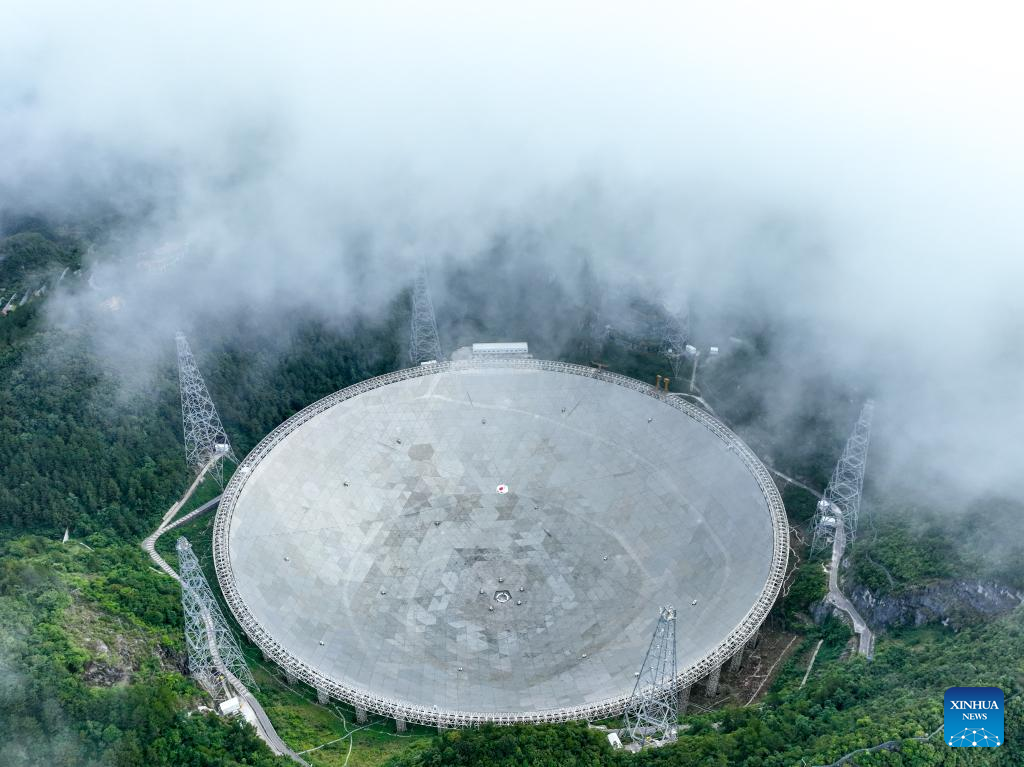In pics: China's FAST telescope in Guizhou

Aerial panoramic photo taken on July 21, 2022 shows China's Five-hundred-meter Aperture Spherical Radio Telescope (FAST) under maintenance in southwest China's Guizhou Province. Located in a naturally deep and round karst depression in southwest China's Guizhou Province, FAST started formal operation in January 2020 and officially opened to the world on March 31, 2021. It is believed to be the world's most sensitive radio telescope. With FAST, scientists have identified over 660 new pulsars. (Xinhua/Ou Dongqu)

Aerial photo taken on Aug. 28, 2019 shows a panoramic view of China's Five-hundred-meter Aperture Spherical Radio Telescope (FAST) in southwest China's Guizhou Province.
Located in a naturally deep and round karst depression in southwest China's Guizhou Province, FAST started formal operation in January 2020 and officially opened to the world on March 31, 2021. It is believed to be the world's most sensitive radio telescope. With FAST, scientists have identified over 660 new pulsars. (Xinhua/Ou Dongqu)

Aerial photo taken on July 21, 2022 shows a view of China's Five-hundred-meter Aperture Spherical Radio Telescope (FAST) under maintenance at sunset in southwest China's Guizhou Province.
Located in a naturally deep and round karst depression in southwest China's Guizhou Province, FAST started formal operation in January 2020 and officially opened to the world on March 31, 2021. It is believed to be the world's most sensitive radio telescope. With FAST, scientists have identified over 660 new pulsars. (Xinhua/Ou Dongqu)

Aerial photo taken on July 21, 2022 shows China's Five-hundred-meter Aperture Spherical Radio Telescope (FAST) under maintenance at sunset in southwest China's Guizhou Province. Located in a naturally deep and round karst depression in southwest China's Guizhou Province, FAST started formal operation in January 2020 and officially opened to the world on March 31, 2021. It is believed to be the world's most sensitive radio telescope. With FAST, scientists have identified over 660 new pulsars. (Xinhua/Ou Dongqu)

Aerial photo taken on the early morning of July 25, 2022 shows a panoramic view of China's Five-hundred-meter Aperture Spherical Radio Telescope (FAST) under maintenance in southwest China's Guizhou Province.
Located in a naturally deep and round karst depression in southwest China's Guizhou Province, FAST started formal operation in January 2020 and officially opened to the world on March 31, 2021. It is believed to be the world's most sensitive radio telescope. With FAST, scientists have identified over 660 new pulsars. (Xinhua/Ou Dongqu)

Combo photo shows China's Five-hundred-meter Aperture Spherical Radio Telescope (FAST) with the first reflection panel installed (upper L, photo taken on Aug. 2, 2015), with nearly half of the reflection panels installed (upper R, photo taken on Dec. 16, 2015), with about 80 percent of the reflection panels installed (lower L, photo taken on March 9, 2016), and a panoramic view of FAST (lower R, photo taken on July 21, 2022), in southwest China's Guizhou Province.
Located in a naturally deep and round karst depression in southwest China's Guizhou Province, FAST started formal operation in January 2020 and officially opened to the world on March 31, 2021. It is believed to be the world's most sensitive radio telescope. With FAST, scientists have identified over 660 new pulsars. (Xinhua/Ou Dongqu)

Aerial photo taken on July 22, 2022 shows a panoramic view of China's Five-hundred-meter Aperture Spherical Radio Telescope (FAST) under maintenance in southwest China's Guizhou Province.
Located in a naturally deep and round karst depression in southwest China's Guizhou Province, FAST started formal operation in January 2020 and officially opened to the world on March 31, 2021. It is believed to be the world's most sensitive radio telescope. With FAST, scientists have identified over 660 new pulsars. (Xinhua/Ou Dongqu)

Aerial photo taken on July 22, 2022 shows China's Five-hundred-meter Aperture Spherical Radio Telescope (FAST) under maintenance in southwest China's Guizhou Province.
Located in a naturally deep and round karst depression in southwest China's Guizhou Province, FAST started formal operation in January 2020 and officially opened to the world on March 31, 2021. It is believed to be the world's most sensitive radio telescope. With FAST, scientists have identified over 660 new pulsars. (Xinhua/Ou Dongqu)

Photo taken with a fisheye lens on July 21, 2022 shows an interior view of China's Five-hundred-meter Aperture Spherical Radio Telescope (FAST) under maintenance in southwest China's Guizhou Province.
Located in a naturally deep and round karst depression in southwest China's Guizhou Province, FAST started formal operation in January 2020 and officially opened to the world on March 31, 2021. It is believed to be the world's most sensitive radio telescope. With FAST, scientists have identified over 660 new pulsars. (Xinhua/Ou Dongqu)

Aerial photo taken on July 22, 2022 shows China's Five-hundred-meter Aperture Spherical Radio Telescope (FAST) under maintenance in the early morning in southwest China's Guizhou Province.
Located in a naturally deep and round karst depression in southwest China's Guizhou Province, FAST started formal operation in January 2020 and officially opened to the world on March 31, 2021. It is believed to be the world's most sensitive radio telescope. With FAST, scientists have identified over 660 new pulsars. (Xinhua/Ou Dongqu)

Aerial photo taken on July 22, 2022 shows a panoramic view of China's Five-hundred-meter Aperture Spherical Radio Telescope (FAST) under maintenance in southwest China's Guizhou Province.
Located in a naturally deep and round karst depression in southwest China's Guizhou Province, FAST started formal operation in January 2020 and officially opened to the world on March 31, 2021. It is believed to be the world's most sensitive radio telescope. With FAST, scientists have identified over 660 new pulsars. (Xinhua/Ou Dongqu)

Aerial photo taken on July 25, 2022 shows China's Five-hundred-meter Aperture Spherical Radio Telescope (FAST) under maintenance in sunrise in southwest China's Guizhou Province.
Located in a naturally deep and round karst depression in southwest China's Guizhou Province, FAST started formal operation in January 2020 and officially opened to the world on March 31, 2021. It is believed to be the world's most sensitive radio telescope. With FAST, scientists have identified over 660 new pulsars. (Xinhua/Ou Dongqu)

Aerial photo taken on July 21, 2022 shows China's Five-hundred-meter Aperture Spherical Radio Telescope (FAST) under maintenance in southwest China's Guizhou Province.
Located in a naturally deep and round karst depression in southwest China's Guizhou Province, FAST started formal operation in January 2020 and officially opened to the world on March 31, 2021. It is believed to be the world's most sensitive radio telescope. With FAST, scientists have identified over 660 new pulsars. (Xinhua/Ou Dongqu)

The long-time exposure aerial photo taken on July 24, 2022 shows a drone performance over China's Five-hundred-meter Aperture Spherical Radio Telescope (FAST), which is under maintenance, in southwest China's Guizhou Province.
Located in a naturally deep and round karst depression in southwest China's Guizhou Province, FAST started formal operation in January 2020 and officially opened to the world on March 31, 2021. It is believed to be the world's most sensitive radio telescope. With FAST, scientists have identified over 660 new pulsars. (Xinhua/Ou Dongqu)

The long-time exposure photo taken with a fisheye lens on July 24, 2022 shows a night view of China's Five-hundred-meter Aperture Spherical Radio Telescope (FAST) under maintenance in southwest China's Guizhou Province.
Located in a naturally deep and round karst depression in southwest China's Guizhou Province, FAST started formal operation in January 2020 and officially opened to the world on March 31, 2021. It is believed to be the world's most sensitive radio telescope. With FAST, scientists have identified over 660 new pulsars. (Xinhua/Ou Dongqu)

Photo taken on Jan. 8, 2020 shows a night view of China's Five-hundred-meter Aperture Spherical Radio Telescope (FAST) in southwest China's Guizhou Province.
Located in a naturally deep and round karst depression in southwest China's Guizhou Province, FAST started formal operation in January 2020 and officially opened to the world on March 31, 2021. It is believed to be the world's most sensitive radio telescope. With FAST, scientists have identified over 660 new pulsars. (Xinhua/Ou Dongqu)

The long-time exposure photo taken on July 25, 2022 shows a night view of China's Five-hundred-meter Aperture Spherical Radio Telescope (FAST) under maintenance in southwest China's Guizhou Province.
Located in a naturally deep and round karst depression in southwest China's Guizhou Province, FAST started formal operation in January 2020 and officially opened to the world on March 31, 2021. It is believed to be the world's most sensitive radio telescope. With FAST, scientists have identified over 660 new pulsars. (Xinhua/Ou Dongqu)

The long-time exposure photo taken on July 25, 2022 shows a night view of China's Five-hundred-meter Aperture Spherical Radio Telescope (FAST) under maintenance in southwest China's Guizhou Province.
Located in a naturally deep and round karst depression in southwest China's Guizhou Province, FAST started formal operation in January 2020 and officially opened to the world on March 31, 2021. It is believed to be the world's most sensitive radio telescope. With FAST, scientists have identified over 660 new pulsars. (Xinhua/Ou Dongqu)

The long-time exposure photo taken with a fisheye lens on July 24, 2022 shows a night view of China's Five-hundred-meter Aperture Spherical Radio Telescope (FAST) under maintenance in southwest China's Guizhou Province.
Located in a naturally deep and round karst depression in southwest China's Guizhou Province, FAST started formal operation in January 2020 and officially opened to the world on March 31, 2021. It is believed to be the world's most sensitive radio telescope. With FAST, scientists have identified over 660 new pulsars. (Xinhua/Ou Dongqu)

The long-time exposure photo taken on June 27, 2016 shows a night view of China's Five-hundred-meter Aperture Spherical Radio Telescope (FAST) in southwest China's Guizhou Province.
Located in a naturally deep and round karst depression in southwest China's Guizhou Province, FAST started formal operation in January 2020 and officially opened to the world on March 31, 2021. It is believed to be the world's most sensitive radio telescope. With FAST, scientists have identified over 660 new pulsars. (Xinhua/Ou Dongqu)

Photo taken on March 29, 2021 shows an interior view of China's Five-hundred-meter Aperture Spherical Radio Telescope (FAST) in southwest China's Guizhou Province.
Located in a naturally deep and round karst depression in southwest China's Guizhou Province, FAST started formal operation in January 2020 and officially opened to the world on March 31, 2021. It is believed to be the world's most sensitive radio telescope. With FAST, scientists have identified over 660 new pulsars. (Xinhua/Ou Dongqu)
Photos
Related Stories
- Libo County promotes tourism consumption in SW China's Guizhou
- 'Colorful Guizhou Style' staged in Guizhou
- Astronomy gives impoverished township in SW China’s Guizhou a facelift
- Huawu village in SW China’s Guizhou thrives on rural tourism
- Culture, tourism highlights of SW China’s Guizhou in 2021
- View of picturesque village in SW China’s Guizhou
- Aerial view of beautiful village in SW China’s Guizhou
- China's FAST telescope under maintenance in Guizhou
- Night economy drives up consumption in Guiyang, Guizhou
- China's FAST telescope detects over 660 new pulsars
Copyright © 2022 People's Daily Online. All Rights Reserved.









